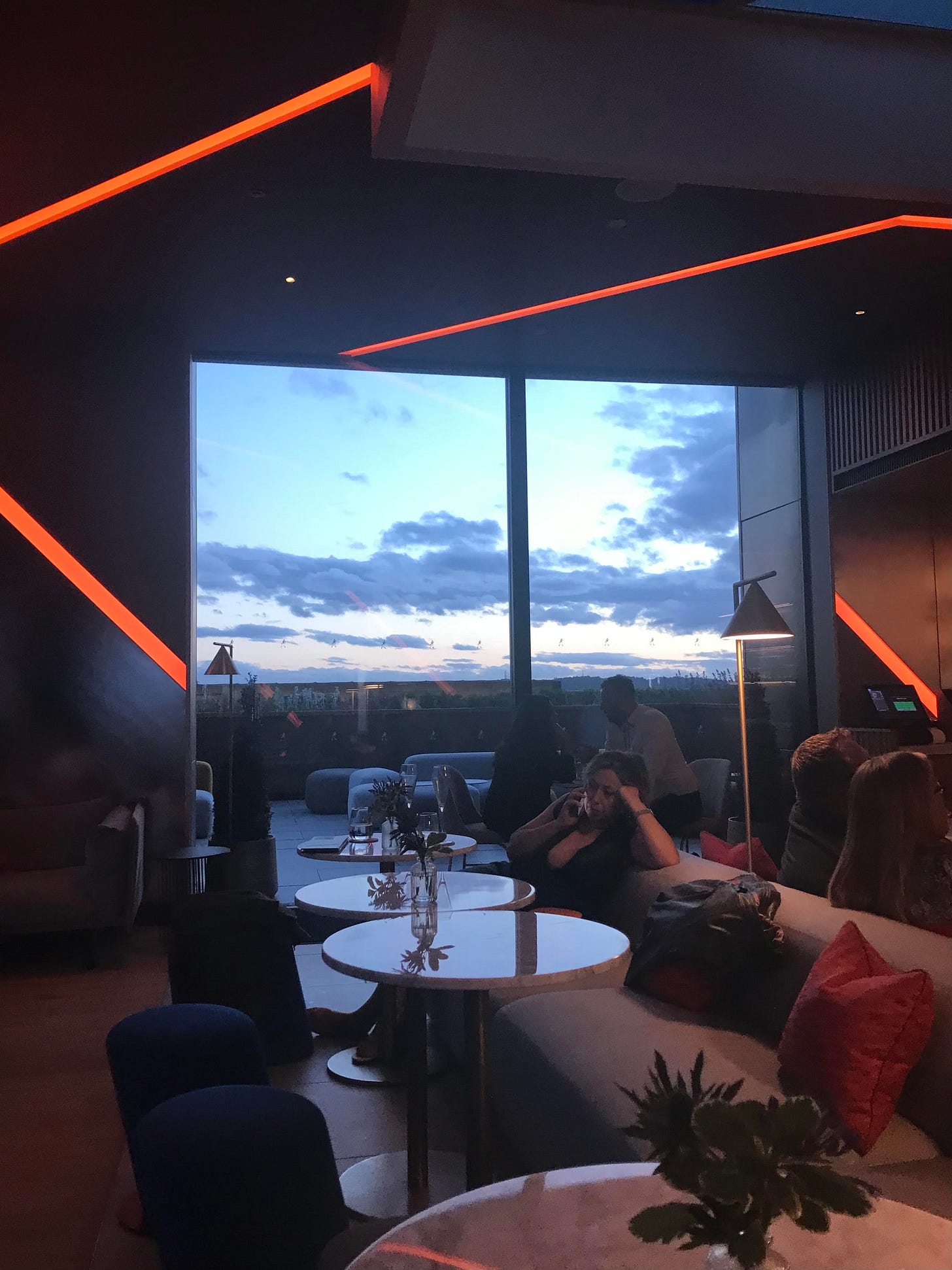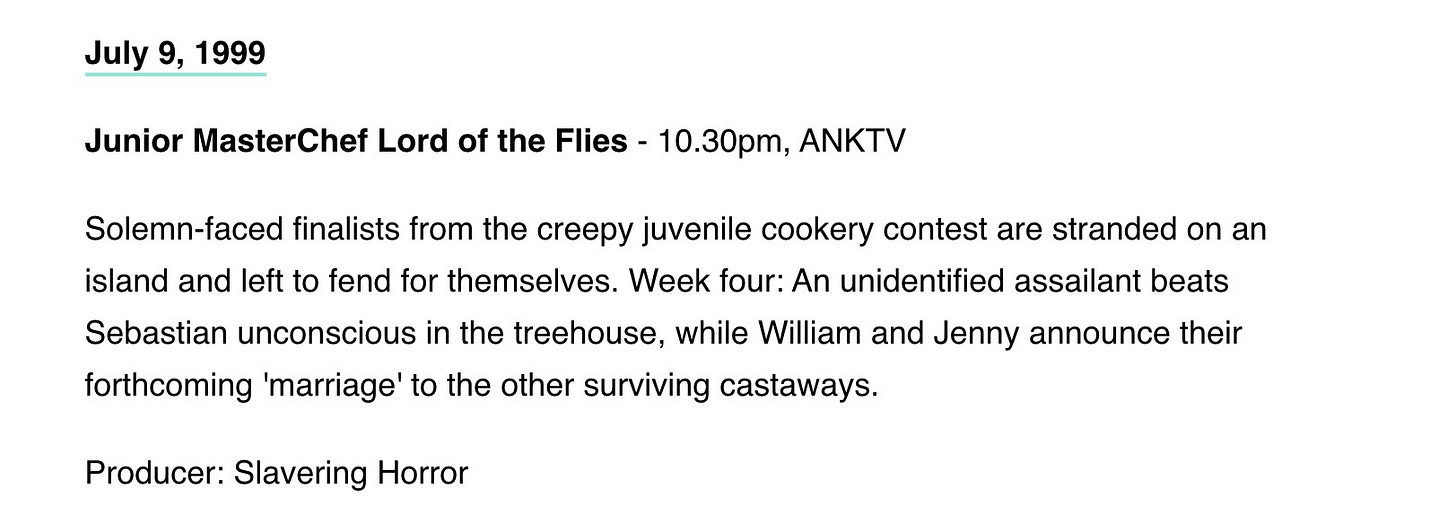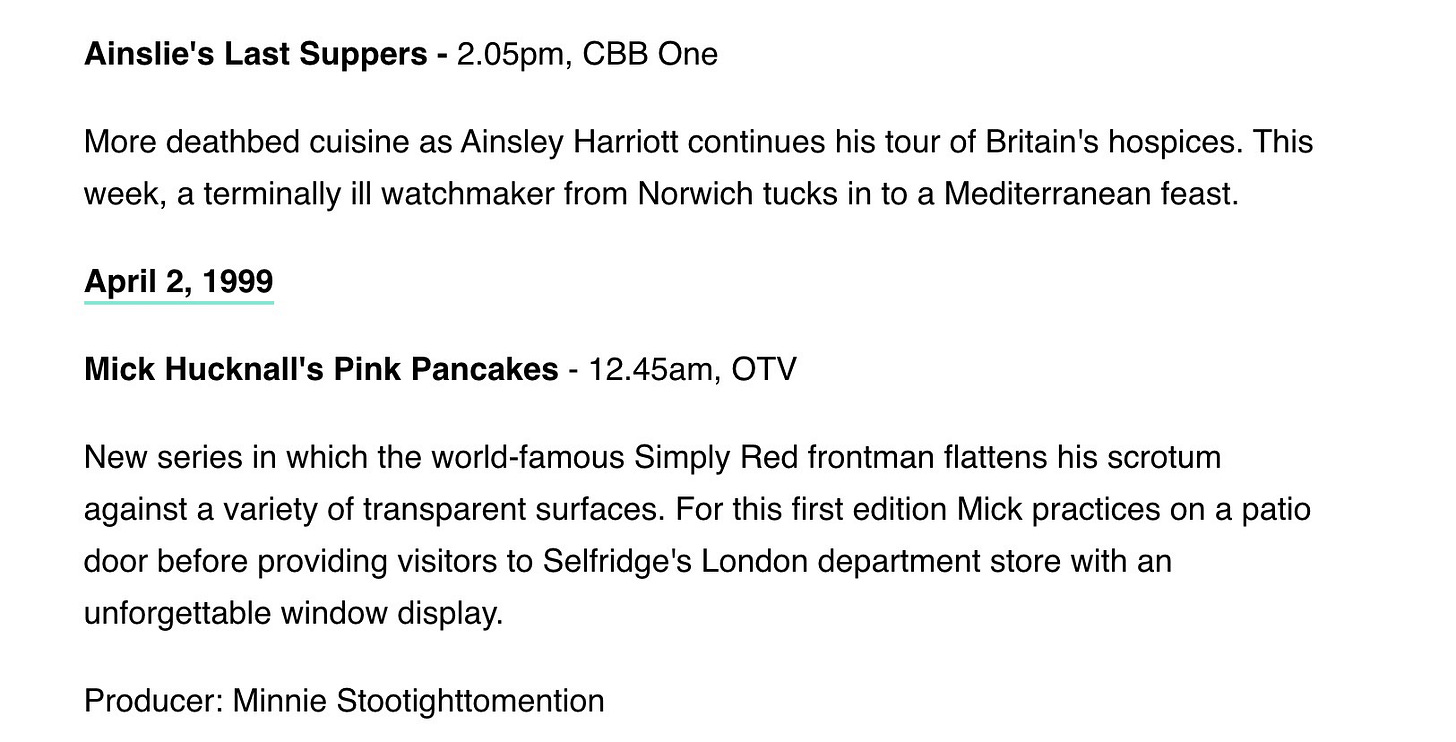I’ve been thinking about many things this month, although I have pledged to write about THE FUTURE during May. Last week’s piece was about a formatative day, a sign of things to come.
Curiously, in the last couple of weeks, I have immersed myself in a hybrid form of the past and the future: returning to a previous job, which nowadays feels much the same and very different, and restoring my bedroom furniture to its default summer position.
Next week, for paid subscribers, I’ll publish a wee poem about a backyard conspiracy of sorts. Some thoughts about hunger, ‘Queering Food,’ and a link to some recipes for joy will follow. For today, a piece about accidental speculative food design that I started writing in 2022 but never found the time to complete!
OMG it’s like the future!
“Oh my god, it’s like the future!”
My friends laughed at how seriously I declared this.
For I like this kind of stuff; I love a speculative future.
We were spending our first time in a rooftop bar with stunning city views, the type of place we wouldn't usually go as locals, the kind of place less common in a historic city like Edinburgh than most other cities worldwide. In-between idle gossip and work updates, we were discussing the high street - and how Diageo's Johnnie Walker seems to be one of few places able to invest in Princes St at the moment, a building now predominantly visited by tourists rather than locals1. The sad truth is our beautiful high street, overlooked by Edinburgh Castle, is mostly empty and boarded, apart from pepperings of American Candy Shops, a brand new Uniqlo, and as I like to call them ‘Tacky Tourist Shops’ - think tartan scarves, plenty of cheap shortbread to buy, bagpipes being blasted over the radio, that kind of thing. This is who has money to invest in these buildings. Make of this what you want.
As a teenager, I picked up a postcard in Habitat (now a Sainsbury's local) of a man holding a postcard with the words "Everything is Connected, the point is to know it and to understand it" and pinned it on my bedroom wall. Years later, I found myself working at that store while studying to design and make furniture, and I often now find myself using the image by Gillian Wearing to describe the complexity of food systems.
I spent much of the time in my previous supply chain job looking at spreadsheets. Updating, ordering stock and trying to fix (Brexit-related) problems. I like systems. But systems aren't always seen as fun or sexy. It's often more fun to spend your downtime laughing at the audacity of the folk who spend their free time leaving scathing comments on Trip Advisor than about regenerative agriculture. Or…reading about the discourse of trad wives, or what hot girls are doing this summer, be it eating tinned fish, or fruit or just grazing with their girl dinners whilst writing poetry about pomegranates…yeah, I could go on and on...
The older I get, the more I enjoy the intersection of pop culture with food trends and culture and how that may affect food systems. Let's face it; systems aren't always seen as fun or sexy - who wants to read about "reinforcing feedback loops" when you can read about a man charging £630 for crap food with a sprinkle of salt? Of course, it's never us (the food service/makers/scholars/workers) laughing all the way to the bank, though.
Unfortunately, or fortunately, I often can't let these little moments of laughter - of cultural significance go. I like to find a place for these abstract thoughts, tucking them into little Google Drive folders with titles like 'Override the finger, yeah? - Nathan Barley and food'; 'Terroir and tableware; What does sex taste like?' and the like. And these ponderings - these "What ifs" have become, or at some point may become design projects for me to creatively explore the "Everything is Connected" - ness of food.
Today, I'm going to take you back to 1999, the year many were petrified technology was going to ground to a halt at the stroke of midnight. Depending on where you're based and your age, you may have yet to hear of TVGoHome, a web publication created by Charlie Brooker that spoofed television schedules using the style of the Radio Times, a popular print publication in the UK. TVGoHome ran from 1999 to 2001 in web form and occasionally in Loaded magazine, and then sporadically until 2003 before being archived.
Having a look at the archive now, it's definitely dated, indeed one of the first posts I see is clearly homophobic (a reminder of how things were), and understandings of intersectionality and access weren't as widespread as they are now, but back in the day its blend of strong language, surrealism, and biting satire, akin to Chris Morris's work, garnered a cult following. Even Morris himself contributed, as 'Sid Peach'. The magazine loved to taunt regular targets, including the Daily Mail, Mick Hucknall, and TV hosts Rowland Rivron and Nicky Campbell. But the real star was fictional: Nathan Barley, a posh media-wannabe whose mockumentary series entitled "Cunt" skewered the self-obsessed, middle-class new media crowd.
Some excerpts from TV Go Home
This TV episode reminds me of recent films ‘The Menu’ and ‘Triangle of Sadness’, both satirical films which didn't really float my boat, maybe because the food satire elements weren't as experimental as my own imagination or knowledge of food trends. If you're really looking to be unnerved, the most fucked-up reality show I have watched in recent times is Deep Fake Love. It's torture porn for those engulfed in the darkest anxieties of heteronormativity.
It's interesting to see Ainsley Harriot mentioned here, as I think we can all agree that he is one of the most wholesome of TV chefs in the UK, even a Reddit National Treasure. Instead, it was Jamie Oliver who told us to Keep Cooking and Carry On (groan) during Covid lockdown screenings.
Brooker eventually hung up his TVGoHome hat, citing the rise of absurd reality TV like "Touch the Truck", where contestants compete to touch a truck for 24 hours! What was once satire now felt too close to reality…too close to home. In 2006, Brooker started a satirical column in the Guardian, dishing out fresh TVGoHome-style listings, but a year prior to that, the late-night TV series ‘Nathan Barley’ screened.
As a 24-year-old night owl who worked 10-hour shifts at the weekend, I watched the first (and only) season and warmed to it instantly. However, it wasn't until the series repeated that it became cult viewing, and people my age and younger were able to quote huge blocks of script at a moment's notice. I remember friendships forming just based on being able to quote Nathan Barley.
Nathan Barley used to introduce himself as a 'self-facilitating media node', and that sums up the premise of the show: a satire created by Charlie Brooker and Chris Morris caricaturing hipster culture, which (probably unintentionally) provided a prophetic glimpse into the future of media, technology, and society.
The word 'hipster' now seems to be used with much less disdain than in 2005. As everyone continues to deny being a hipster, I like to casually throw out the theory that hipsters don't really exist, that it’s probably just a slur...2
The real question may be, if the idiots are still winning, who are the real idiots? If the idiots were winning back in 2005, it would seem they grew up and became embedded in the institutions that love tech and wield power. Nowadays, independent media outlets have more opportunities to publish freely without censorship.
Nathan Barley and Food
In this excruciating interview, long-suffering hipster/idiot-avoider Dan Ashcroft is trying to leave his indie publication job and get work in the mainstream media but lacks the cultural capital to answer the questions. He may feel he shouldn’t be at ‘SugarApe’ (Nathan B’s publication), but neither would he fit in at ‘Weekend on Sunday’. More excruciating than the interview itself is what I perceive as the punchline to the scene - that it would be implausible to find Greek wine on supermarket shelves back then. Luckily, things have moved on, good Greek wine is no longer scorned.
I'm curious what type of publication Dan Ashcroft would be writing on Substack nowadays, or whether he would have secured a job in mainstream food media. Something Rayner-esque, maybe?!
Regime is the restaurant to be seen at in Nathan Barley. And this clip sure packs in a lot for food nerds to observe. In this scene, we see diners prioritise photographing their food before eating it and the reactions of the couple to this by another older, middle-class couple. We also see an early version of personalised gastronomy; the premise is that the finger sensor “analyses the mineral balance; tells you what you should eat.” Sound familiar?
At Regime, we also see casual cultural appropriation, with beer gourds being used without specific context, which is something that Nathan scorns, embarrased at his lack of understanding.3
In this last clip I’ve selected, Dan Ashcroft - a frustrated journalist and colleague of Nathan Barley, gets frustrated by Nathan's attempts to mimic Dan's takeaway coffee order and so ends up adding smoked salmon to his coffee to spite him. Unsurprisingly, this flavour combo never took off, but do not fear; you can always reverse it and cure your salmon in coffee and thyme. In the meantime, if you're looking for more experimental ideas to play with your boundaries of distaste, check out Food Is Stupid.
Fans of Nathan Barley will understand the show was a natural predecessor to the more commonly distributed Black Mirror, also created by Charlie Brooker.
Much has been written about how Black Mirror has acted as trend predictor4 for our most dystopian aspects of society. Most recently, Thom Waite wrote this in Dazed Digital:
By now, Black Mirror is essentially shorthand for the fear and uncertainty we feel about our modern, fast-changing world. Any time a new technology is unveiled, references to the dystopian anthology series flood the comment sections on social media.
The fact this article was published on 6th October seems even more dystopian given where we are 220 days later:
زنانة , (drones) continue to buzz and citizens are starved, tortured and dehumanised like roaches in Gaza;
The pig-fucker has come back out of his pen to lead our complicity in genocide;
We block/downgrade the celebrities/influencers we deem to be idiots due to their silence or political beliefs.
Our love for satire and scathing, satirical humour has ended up speculatively creating a world where a meme from 2017 has become an empire; Silicon Valley feels no shame at adopting a 1973 ecological dystopian thriller as its brand name; and a Charlie Brooker/Chris Morris comedy showing us the hipster-ification of the city in ways we once laughed at, somehow came true.
I wonder, during uncertain times, whether pondering “What if?, can create tangible alternatives to the Black Mirror-esque dystopian societies we are hurtling ever-faster towards. To actively shape and redesign the futures we so desperately need.
Remember, choose your gurus wisely.
The Future Catherine Bennett, by performance artist Bryony Kimmings - This pop song was co-created with her niece.
Fundraiser for Watermelon Relief
I’m bringing back ‘Fingerlimes & Clementines’ pop-up shop for the month of May! 🍉
All profits during the month of May will be donated to both @watermelonrelief who provide food aid to displaced families in Gaza, and to @sumudedinburgh, who are campaigning for a #freepalestine in our local community.
Find a lovely range of gifts and homeswares with a food theme from local and sustainable designers ! 🍊🍋🍉
Due to costs, we are only shipping goods in the UK, but if you would like a quote for elsewhere please do get in touch!
For more on Diageo, whisky and terroir, check out these pieces by Robbie Armstrong and by Margaux Vialleron.
If you’d like to read more about hipster theory I recommned the following (not just for the great title!):
Athill, C.N., 2018. Who Are You Calling a Hackney Twat? Gender and Stigma in Media Representation. Journal of Extreme Anthropology, 2(1), pp.46-65.
For more on gourds, visit Sourced Journey’s season on…gourds, starting with this piece: https://www.sourcedjourneys.com/post/gourds-who-gets-to-tell-the-story
Or accidental speculative designer?






